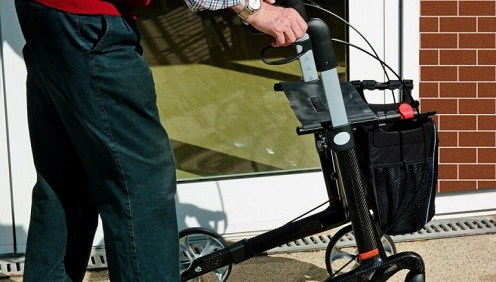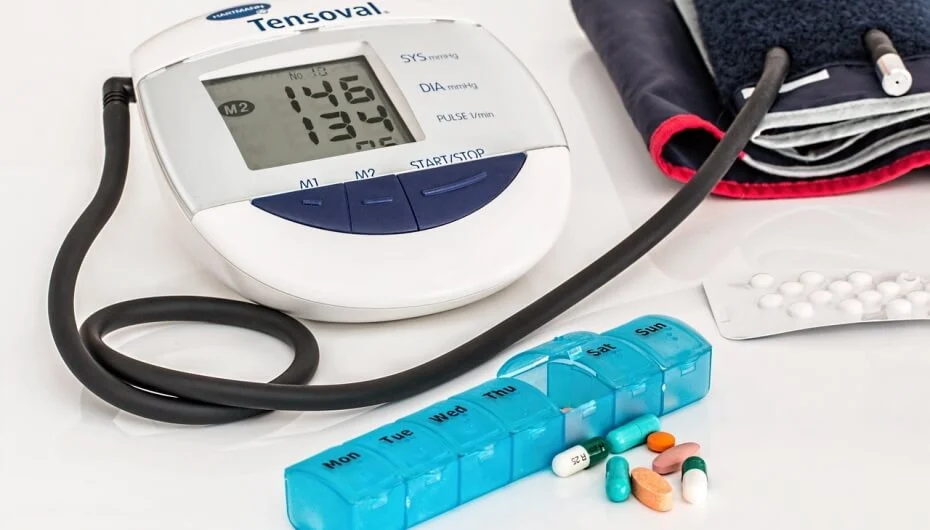How to Prevent Strokes in Senior Patients

How to Prevent Strokes in Senior Patients January 11, 2024 Helping older people prevent strokes is essential to care for their long-term health and well-being. Preventing the consequences of suffering a stroke can be as simple as enjoying a healthy diet and getting enough exercise. To reduce the risk of stroke when caring for an elderly loved one, it is also necessary to make sure they take their medication. The consequences of a stroke can leave a senior person needing extra home care or hospital care because of being temporarily or permanently debilitated. Complications of strokes can include loss of speech, loss of movement, and can even be fatal. Stroke Prevention in the Elderly According to the National Institute of Neurological Disorders and Stroke, nearly 80% of strokes are preventable. Many of the risk factors for stroke can be avoided or managed with early intervention and care. Because of prevention strategies, the number of people suffering from a stroke in the U.S. has almost halved in recent years. This means that any positive changes you make today can have a great impact in helping to keep the person in your care as healthy as possible Ways to Prevent Strokes in Seniors Let’s at some simple ways that you can help to lower the risk of a loved one suffering from the consequences of a stroke. 1. Treat hypertension To avoid strokes in older persons, it is important to control high blood pressure. Many doctors agree that hypertension is one of the biggest risk factors for stroke. Some ways to control blood pressure include reducing sodium, lowering cholesterol, in increasing the consumption of fruit and vegetables. It is also important to take hypertension medication. 2. Get more exercise If possible, you should help the person in your care increase their level of exercise. Getting more exercise has the benefit of helping to lower blood pressure and reducing weight. This could involve regular walks, light resistance training, or some aerobic exercising for seniors. Before starting any new exercise regime, it is important to talk with the senior person’s doctor. 3. Limit alcohol consumption and stop smoking Bad habits such as overconsumption of alcohol or smoking can greatly increase the risk of stroke. Many doctors say that limiting alcohol consumption of one drink a day can help prevent stroke. Smoking clogs up arteries and affects blood circulation which can cause stroke, cancer, or lead to a heart attack. Product Category Years
Handy Tips to Help Seniors Improve Their Memory

Handy Tips to Help Seniors Improve Their Memory January 4, 2024 Memory loss is one of the most significant challenges in senior years. Forgetting details, facts, and events can cause frustration and anxiety. Additionally, not remembering doctor’s appointments or taking medication could have serious health consequences.What can you do to help a senior person improve their memory? This article contains some handy tips on helping a loved older person to remember things easier. 1. Get adequate sleep to boost memory Getting enough sleep is vital to help prevent memory loss. A study by the American Physiological Society found that sleep benefits the retention of memory. The researchers found that sleep consolidates memory and makes it easier to recall facts in the future. Also, it’s vital that sleep is uninterrupted to enhance long-term memory.For most seniors, getting between six and nine hours of sleep per night is ideal. 2. Enjoy a healthy diet to protect against memory loss A diet low in saturated fats and high in polyunsaturated fats is vital to maintain excellent mental health. According to a 2021 study, a Mediterranean diet can help protect against dementia and memory loss. In addition, a diet rich in vegetables, fruit, cereals, fish, and olive oil helps to increase blood flow in the brain. This reduces the risk of stroke and memory loss. 3. Stay active to help prevent forgetfulness Staying fit and active is another way to improve mental health and reduce the risk of memory loss. The journal Frontiers in Aging Neuroscience reported that one to three hours of aerobic exercise could help to improve cognition, brain health, and cardio fitness. Other studies have found that regular exercise stimulated neural growth and helps repair brain cells. 4. Keep the mind active to help improve memory Taking part in any activity that keeps the mind active is essential to improve the ability to recall facts and remember things. For example, learning a musical instrument, having a hobby, mastering a new skill, or even doing math in your head are excellent ways to stimulate and exercise the brain. 5. Stay socially active Staying in touch with family and friends or being part of a social group is vital for better memory. In addition, researchers have found that having a more extensive social network helps protect against cognitive decline. For example, the study using mouse models revealed that the animals who lived in groups had better memory recall than those who lived independently or in pairs. Product Category Years
How to Use Assistive Care Devices in the Home Properly

How to Use Assistive Care Devices in the Home Properly December 28, 2023 Assistive care devices can help seniors deal with mobility issues and improve their quality of life. High-quality aids to provide assistive care can include wheelchairs, walking canes, hearing aids, adaptive switches, and specialized handles and grips. Using assistive devices in the home requires special care to prevent injuries and boost well-being. How can you or a loved one use assistive care devices properly? In this article, you’ll find out some handy tips on the safe use of assistive devices The Challenge of Using Assistive Care Devices at Home It can be challenging for an older adult to get around the house using a walker, cane, or wheelchair. Most homes are not designed for using mobility aids. This means that doors can be too narrow, countertops too high, and sinks can be difficult to access.According to the journal Population Health Management, medical devices can be challenging to use for someone with impaired mobility, hearing, eyesight, or cognition. Very often, someone who uses mobility aids for the first time is already dealing with tough circumstances. So, learning to use assistive devices can be confusing. How to Use Assistive Care Devices Properly Using assistive care devices safely is vital to protect health. Additionally, it is also necessary to ensure that the person has the right device, receives training, and that the device functions correctly. This way, the mobility aid will help rather than increase the risk of injury.Here are five ways to ensure that anyone using an assistive care device does so correctly. 1. Use the right assistive care device Using a suitable assistive device is essential. There are many types of walking aids, each with its own function. The right mobility aid should ensure that the user is stable on their feet. Also, it’s crucial to consider a person’s strength. For example, a cane is only for someone with no balance issues. An older adult who’s shaky on their feet may need a walker. 2. Give proper training Even using a basic mobility device requires training on its proper use. Ideally, a qualified healthcare supervisor should provide training to the user and caregivers. In the first few days or weeks, it would be best that someone is on hand to provide extra assistance. 3. Make sure the device fits or is the proper size Ensuring that the assistive device is the right size prevents muscle strain or accidents. Typically, the right fit takes into account weight, height, and balance. For example, elbows should be bent at 15 degrees when holding canes and walkers. Ill-fitting equipment can lead to repetitive strain injuries. 4. Maintain assistive equipment properly Caregivers and practitioners should ensure that equipment is used correctly and well-maintained. For example, walking aids usually have rubber caps and hand grips to increase stability. Poor maintenance could lead to slips, falls, and avoidable injuries. 5. Make sure the assistive device fits in the home Before bringing mobility equipment home, it’s crucial to ensure that it will fit. For example, if someone uses a wheelchair at home, the device should comfortably fit through doors. In some cases, it may be necessary to make modifications in the house to increase safety and allow the safe use of assistive care devices. Product Category Years
Senior Care — How to Prevent Falls at Home

Senior Care — How to Prevent Falls at Home December 21, 2023 Fall prevention is a vital part of caring for seniors who live at home. Falling in the house is one of the most significant risks to adults over the age of 65. Unfortunately, falling can result in serious injuries that impact a senior’s mobility, quality of life, and homecare. In some cases, a broken hip or other bone could require major surgery.If you are caring for an aging loved one, you can do much to prevent falls at home. In most cases, installing grab bars, reducing trip risks, and adapting bathrooms are the essential ways to eliminate the chances of falling. However, there are more things you can do to make the home safer for a senior person. The Dangers of Falling at Home According to studies, falls in the home are among the most common and serious issues among seniors. Statistics show that over 30 percent of over 65s fall every year. From these incidents, 10 percent of falls result in serious injuries requiring hospitalization. Risk factors for falls include the following: Balance impairment Reduced muscle strength Poor eyesight Arthritis Taking more than four medications 5 Ways How to Prevent Falls at Home Let’s look at some simple ways to reduce fall risks and prevent serious injury to an aging loved one. 1. Install grab bars Grab bars are easy to install and can help seniors from falling. Grab bars also allow seniors to remain independent by helping them to feel more confident about moving around the home. It’s vital to ensure that the bars are professionally installed and suitable for the person. 2. Adapt bathrooms to make them safer Bathrooms pose a significant risk for falling. Wet floors are easy to slip on, and bathroom installations—baths, sinks, and toilets—are usually hard, unforgiving surfaces if you fall on them.First, grab bars are essential in a bathroom. Second, it’s vital to have non-slip mats with rubberized backing to prevent slipping. Also, make sure that the shower or bathtub has a non-slip surface.Other essential bathroom items to prevent falling include a shower seat and a raised toilet seat. 3. Improve lighting Adding lighting in a home is a great way to prevent tripping and falling. It’s a good idea to make sure that there’s a light switch at each doorway. Also, motion sensors that automatically turn on lights can help a senior navigate the house when it’s dark outside. 4. Eliminate tripping hazards Make sure all trip and slip hazards are removed from the home. These hazards include electric cords, throw rugs, or worn carpeting. Make sure that any carpets or rugs are securely fixed to the floor. Top tip for senior homecare: Remember that wooden and tiled surfaces have a greater risk for falling than carpets. 5. Improve stairway safety Stairs in a home are a significant risk. So, make sure that handrails are securely fixed to the wall. Additionally, steps should have a non-slip surface and be well-lit. In some cases, installing a high-quality stair lift is one of the best options to increase safety and reduce a senior’s risk of falling at home. Product Category Years
5 Ways Seniors Can Save Money on Medication

5 Ways Seniors Can Save Money on Medication December 14, 2023 With rising healthcare costs, it makes sense for seniors to find ways to save money on medication. People living on Medicare have a fixed income and typically have various health concerns. This means that it can be costly to buy prescription drugs. However, there are ways to reduce the cost of healthcare and find cheaper prescriptions.According to figures, seniors in the US take between 14 and 16 prescription drugs a year. However, prescription prices continue to rise. For example, it was reported that medication costs rise faster than the rate of inflation. In some cases, the cost of brand-name drugs has increased 130 times faster than the rate of inflation.How can a person over 65 save money on medication without risking their health? This article has helpful tips on where to find cheaper prescriptions. 1. Ask about generic drugs One of the easiest ways to save money on medication is to switch to a suitable low-cost generic drug. Your doctor can let you know about FDA-approved alternatives to brand-name prescriptions. In many cases, generic medicines can be 30 to 80 percent lower than brand names. These drugs are typically for treating common issues facing seniors—diabetes, high cholesterol, high blood pressure, and more. 2. Find a reliable mail-order pharmacy Many pharmacies have discount plans if you order prescriptions online. Of course, it’s vital to ensure that the pharmacy is legitimate and approved by the FDA. It may be possible to save money by ordering a three-month supply. 3. Look for a better Medicare plan You could help a loved older person reduce prescription costs by finding a different Medicare drug plan. Some plans offer discounts on prescription medication and could help reduce out-of-pocket costs. You can also contact their current insurer to ask if there are any ways to save money on monthly prescriptions. 4. Research state programs Many states have programs to help low-income individuals receive free or reduced prescriptions. So, it is worth contacting your local Social Security office or Medicare to see what assistance is available locally. 5. Get assistance from the drug manufacturer Most pharmaceutical companies run a Patient Assistance Program (PAP). These programs help struggling folk to cover the cost of medication. It may be possible to get free or reduced-cost drugs. PAPs are available for people with or without insurance. Product Category Years
Home Care vs. Nursing Home Care — How to Choose

Home Care vs. Nursing Home Care — How to Choose December 11, 2023 Choosing between home care and nursing home care can be a heart-wrenching decision. On the one hand, home is where your loved one feels safe, secure, and comforted by their memories. But on the other hand, a nursing home can provide a level of care that is almost impossible to achieve in the home setting. This article looks at some things to consider if you need to decide on the best course of treatment for a loved one in your care. Home Care Benefits and Disadvantages The benefits of pets for seniors are weIn most cases, a senior person starts receiving care at home. This is because the aging process is slow and gradual, and the house is adapted as needs change. It is also possible to arrange a high level of professional medical care at home. ll-documented in medical literature. For example, the journal Aging & Mental Health reported that pet ownership is associated with positive mental health outcomes. This was found to be especially true in community-dwelling situations. The Benefits of Home Care One of the benefits of continuing caring for someone at home is the one-to-one contact with the caregiver. In addition, the aging family member usually feels more comfortable in the familiarity of their home. However, the most significant advantage is independence. Typically, the senior person can make their own decisions. The Disadvantages of Home Care The two main concerns with home care are hiring a caregiver and safety. Because home care involves regular personal contact with one person, the relationship with the caregiver can make or break the arrangement. Of course, the other issue with home care is health and safety. Homes generally don’t have the specialized medical equipment that healthcare facilities have. As a result, your loved one may be at risk of falling or other hazards around the home. Nursing Home Care Benefits and Disadvantages Also called skilled nursing facilities, nursing homes are designed to provide specialized long-term care. The convalescent home offers a combination of housekeeping and nursing services, carried out by trained, professional staff. In most cases, care is available 27/7, 24 hours a day. The benefits of nursing home care Peace of mind is usually the most significant benefit of a nursing home. Families can be sure that their loved ones get the medical care they require. This can take a lot of strain from family relationships and protect the physical and mental health of family members. In addition, there is better security in nursing homes, and older folks have more socialization opportunities. Many homes organize game nights and outings and encourage hobbies like crafts or art. The disadvantages of nursing home care Typically, most seniors are reluctant to go into a nursing home. The change in surroundings can be upsetting, and they may resent losing some of their freedom and independence. One of the other factors to consider is cost—care in a nursing home is significantly more expensive than home care.Whatever option you choose — in-home care, private home care, adult day care, or assisted living — you should discuss the options with everyone involved to work out what is best. Product Category Years
Home Care Devices to Help Reduce Visits to the Doctor

Home Care Devices to Help Reduce Visits to the Doctor November 30, 2023 Home care devices can greatly reduce the need for seniors to make frequent trips to the doctor. Many easy-to-use home care products can help check blood pressure, blood sugar and monitor physical activity. There are also home care products to manage pain and stiffness. Of course, seniors must inevitably visit the doctor for regular checkups, tests and to diagnose new conditions. But investing in the best home care devices can save you money, time, and frustration. Not only that, monitoring certain conditions at home is better for senior citizens. It’s important to remember that the best way to avoid visiting the doctor is to stay physically, emotionally, and mentally fit. What are the best home care devices to help lessen the need for some doctor visits? Here are the top care products you can buy. 1. Blood Pressure Monitor It a good idea for seniors to have access to a blood pressure monitor at home. The easy-to-use device measures blood pressure, heart rate and checks for irregular heartbeats. The best blood pressure monitors also keep records of past readings — ideal for monitoring blood pressure over a long time. 2. Diagnostic scale A diagnostic scale can help seniors to monitor their weight and physical activity. The latest diagnostic scales are not just to check weight. You can get models that are designed to help anyone stay fit and active. The scale connects to various lifestyle apps that have exercises and diet plans specifically for older adults. 3. Electric heating belts For anyone who suffered from joint stiffness, electric heating belts are ideal. The heating belts wrap around knees or elbows to soothe stiffness and help reduce pain. These home care devices have adjustable heat settings for managing most types of joint pain. 4. Freezable Orthopedic Support Some types of pain and muscle soreness are managed best with cold treatment. A re-freezable orthopedic medical pad can help reduce muscle spasms, pain, and inflammation. All you need to do is freeze the pad for an hour and then place it on the sore body area. 5. Home Safety Devices In addition to home care devices, it’s vital to install safety equipment around the home to prevent falls, trips, and accidents. Some excellent assistive devices include grab bars, toilet seat risers, over-bed tables, button loopers, and grabbers. Many of these personal care devices help prevent visits to the doctors and increase a senior’s independence. Product Category Years
Top Tips When Walking with Aging Parents

Top Tips When Walking with Aging Parents November 23, 2023 Walking is one of the best forms of exercise for elderly people because it has many health benefits. Light exercising such as walking helps to strengthen bones, reduce blood pressure, improve stamina, and reduce anxiety. Walking with elderly parents also helps to keep you healthy and strengthen family bonds. However, there can be challenges when walking with aging parents. They may have mobility issues or gait disorders and can make walking painful. Even getting up from a sitting position can be difficult for some. What can you do if you want to help a loved elderly person walk more? Suggestions for Walking with Elderly Persons Here are some top tips to make walking with older people both safe and pleasurable. Get advice from their caregiver It is important to speak to their caregiver or doctor to get advice on what kind of walking would be suitable. The doctor will be able to advise on what exercise will provide the most benefit for your loved one and what you should avoid. Encourage the use of assistance aids In some cases, it may be a good idea to encourage the use of a cane or walker. It is natural that an elderly person is hesitant at first. So, you could try to emphasize the benefits of walking devices to their health stamina. Get the proper footwear You need to make sure your elderly parent has footwear appropriate to the conditions and terrain. Shoes should fit comfortably and not press or pinch their feet. You also make sure that footwear will not slip in wet or icy conditions. If you decide to walk in the countryside, then appropriate boots or other footwear may be necessary. Be aware of obstacles When walking, you should be extra aware of any potential obstacles on the path. This could be a broken sidewalk, branches, rocks on the path, or potholes. In some public places like parks or shopping malls, you should also be aware of other people who could inadvertently bump into your loved one. Product Category Years
How To Choose the Best Adjustable Bed

How To Choose the Best Adjustable Bed November 17, 2023 Knowing how to choose the best adjustable bed is important for anyone who has to spend a lot of time in bed and who has special needs. Having a comfortable bed, which is easy to adjust and maneuver can add greatly to a person’s quality of life and also make it easier for the care-giver.If you are looking to choose the best adjustable bed for your, or a relative’s needs, what should you keep in mind? Type of Adjustable Bed The first consideration is which kind of adjustable bed you need. You can choose between manually adjustable beds, semi-electric beds, and electric beds. For example, manually adjustable beds tend to be cheaper, but are more difficult to adjust. However, electric adjustable beds will be bulkier, and more expensive, but will move at the touch of a button. You should also take into consideration the height of the bed to make it easier to get in and out of bed. Also, if it is difficult to turn the person in bed, some beds have a function which makes it easier to turn them. Mattress Choosing the right type of mattress is also important for the right kind of bed. Some mattresses will help to reduce pressure and that can help a person stay comfortable if they have to spend a long time in bed. Depending on the health needs of the person, you may need a mattress that is waterproof and can be easily cleaned. Safety Features If you are looking to buy an electric adjustable bed, it’s essential to make sure that there are safety features to avoid injuring someone. For example, if there is an obstruction like a arm or leg, an anti-entrapment mechanism will sense this can stop the bed movement. Weight Limit You should always check the weight limit of the bed, especially if it is for someone over 280 lbs. The various mechanisms in the bed need to be able to support the person properly and adjust appropriately. Product Category Years
How Pets Can Boost the Wellbeing of Seniors

How Pets Can Boost the Wellbeing of Seniors November 17, 2023 Pets have a fantastic ability to benefit the welfare of older persons. Many breeds of cats and dogs become loyal friends who provide unconditional love. In addition, having a furry friend in the home can help seniors cope with loneliness and brings a renewed sense of purpose. And pets that require walking can also help keep an older adult active. Of course, choosing the right animal before selecting a pet for a loved person in your care is crucial. For example, a large breed of dog that is highly excitable isn’t going to be a good match for an elderly parent dealing with mobility issues. However, many breeds of dogs and cats have temperaments and behavior ideal for older adults. This article examines how getting a pet could benefit the well-being of seniors. The Science Says Pets Benefit Older Adults The benefits of pets for seniors are well-documented in medical literature. For example, the journal Aging & Mental Health reported that pet ownership is associated with positive mental health outcomes. This was found to be especially true in community-dwelling situations. Another study published in Frontiers in Public Health found that pets positively impacted older adults’ everyday life during the coronavirus pandemic. In addition, scientists discovered that having a pet can fulfill particular emotional and social needs, especially regarding feelings of isolation. Three Ways Pets Can Boost the Wellbeing of Seniors Calm and friendly pets have an amazing ability to relieve tension and reduce stress. Studies show that stroking a cat or dog helps release endorphins that boost mood. And because older adults have a new focus, they are less likely to dwell on negative issues. In the study mentioned earlier, 80 percent of respondents said that pet ownership was associated with stress relief, purpose, love, and support. 1. Pets promote physical fitness In the study meDogs keep their owners active because they need regular walking. So whether it’s playing fetch in the yard or taking a walk around the block, dogs help their owners stay fit and prevent a sedentary lifestyle. ntioned earlier, 80 percent of respondents said that pet ownership was associated with stress relief, purpose, love, and support.Being physically active is vital for seniors because it promotes good health, including keeping bones strong and muscles toned. People who engage in regular physical activity also improve their overall fitness levels, reducing the risk of falling and injuries. 2. Pets can help around the house Even a dog without training as an assistance animal can learn basic commands and tasks. For example, seniors may be able to teach dogs to retrieve things, pick up dropped items, walk right beside them, and close doors. They are also excellent deterrents against anyone considering breaking in. 3. Pets increase social activity and interactions Owning a pet may lead to new social interactions. For example, dog walkers have great camaraderie, and it’s easy to start conversations with strangers. Also, there are opportunities for further interactions with the vet, pet store owners, and other pet owners. A pet can provide unconditional love and may improve the happiness, health, and comfort of an older adult. However, before committing to an animal, consider the amount of care and attention needed carefully. Also, ensure that the senior and the animal are a good match. Product Category Years







